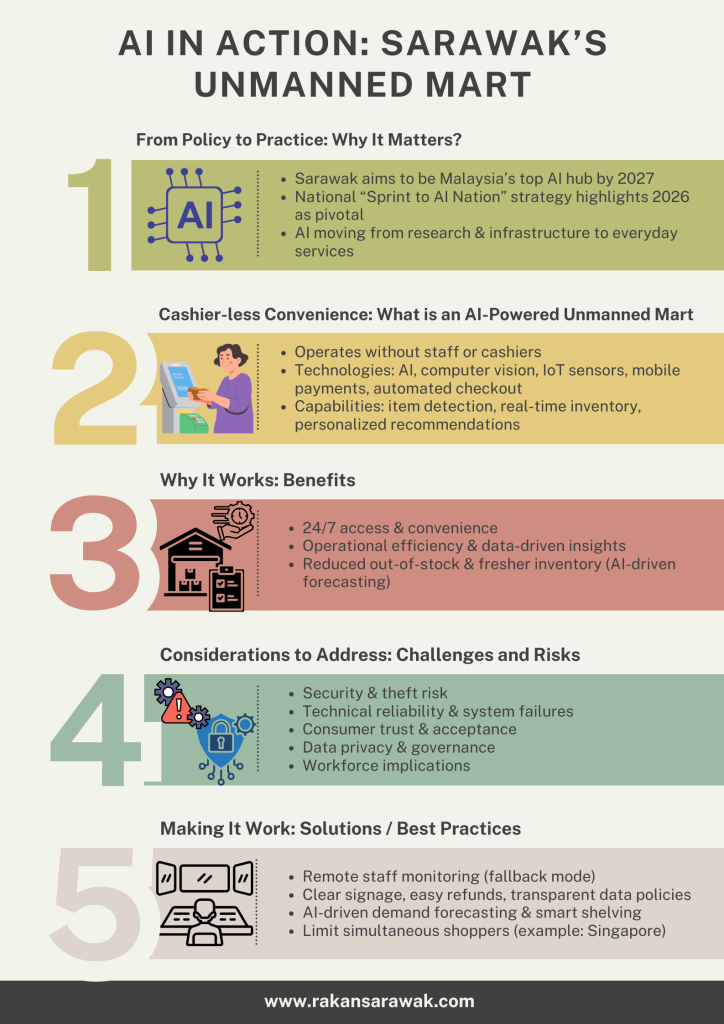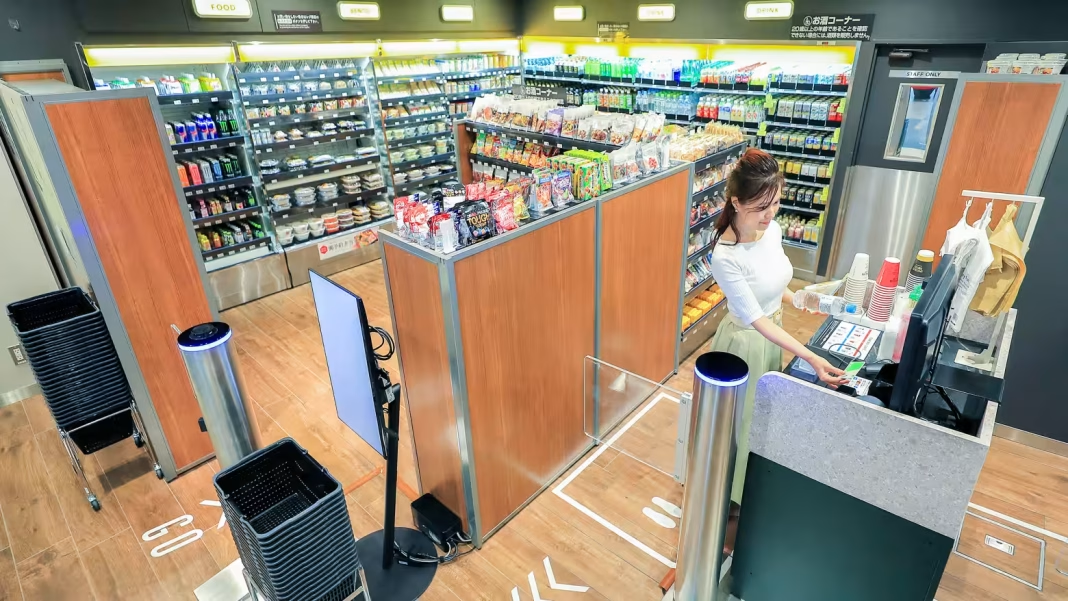The state of Sarawak is actively positioning itself within Malaysia’s broader ambition to become an AI-enabled economy by 2030.
At the national level, the “Sprint to AI Nation” strategy identifies 2026 as a pivotal milestone in this transformation.
Meanwhile, in Sarawak, initiatives such as the Sarawak Artificial Intelligence Centre (SAIC) and local prototypes like the “DeepSight” health-monitoring platform demonstrate tangible efforts to integrate AI into public sector and economic applications.
By publicly aiming to become Malaysia’s top AI hub by 2027, the state has created fertile ground for innovations such as the AI-powered unmanned mart that was launched recently, the e-Mart Smart Tap & Go Mart at Baitulmakmur II.
This launch marks a milestone, illustrating that AI applications are extending beyond research and infrastructure to everyday retail and community services.
Definition
An unmanned mart, also known as an unmanned convenience store, is a retail outlet that operates without on-site staff or cashiers.
Instead, it utilises technologies such as Artificial Intelligence (AI), computer vision, Internet of Things (IoT) sensors, mobile payments, and automated checkout systems to manage the customer experience.
When enhanced with AI, the store becomes an “AI-powered” unmanned mart: cameras and sensors detect items taken, track shoppers’ movements, reconcile payments, monitor stock in real time, and may even provide personalised recommendations or services.
Globally, these stores are referred to as “cashier-less” or “just walk out” stores.
In the case of Baitulmakmur II, customers can enter, select items, and pay through the system independently—allowing uninterrupted 24/7 access, smoother operations, and a data-informed retail experience.
Considerations and Risks in Introducing This Innovation
While the technology is promising, it presents several concerns that must be addressed, such as:
Security and Theft Risk: With no staff on the floor, unmanned stores can become targets for theft or misuse.
Trials conducted in Singapore revealed that AI-based detection systems can be easily confused in situations involving multiple customers, resulting in mischarges or missed items.
Technical Reliability and System Failures: The dependence on interconnected sensors, imaging systems, and AI algorithms exposes the mart to operational disruptions in the event of system failures or inaccuracies, potentially affecting public trust.
Privacy and Data Protection Concerns: High levels of sensing, video recording, data analytics, and payment integration create potential issues around how personal data is collected, stored, and managed, as well as whether proper consent and compliance procedures are in place.
Consumer Trust and Acceptance: For some shoppers, the absence of human assistance can be uncomfortable, particularly in situations involving queries or disputes.
Research from Sweden indicates that individuals with lower tech comfort levels are significantly less likely to adopt unmanned retail.
Job Displacement and Labour Implications: The introduction of automation could lead to fewer on-ground staff, raising issues related to job displacement, reskilling needs, and its overall effect on local employment.
Drivers Behind the Emerging Issues
The Complexity of Real-World Retail Environments: In-store conditions introduce numerous variables such as uneven lighting, overlapping shoppers, and items being picked up and returned elsewhere, making accurate detection harder than in laboratory simulations.
High Technology Demand: Accurate detection of items, linking them to the correct shopper, and reconciling payments require complex AI algorithms, resilient sensor networks, real-time processing, and continuous calibration.
These requirements, coupled with significant initial and ongoing costs, raise questions about system reliability.
Human Factor and Trust Gap: Consumer comfort often depends on staff assistance; eliminating this layer may lead to friction, especially in situations involving mistakes or unclear charges.
Data/Ethical/Regulatory Lag: Many jurisdictions are still evolving their legal and regulatory frameworks for data privacy, consumer protection, and cashier-less retail, which can result in unmanned models proceeding in the absence of full regulatory clarity.
Scale and Localisation Challenges: While the unmanned model performs effectively in high-density, high-traffic urban areas with reliable connectivity, it may face challenges in regions with lower population density, weaker network infrastructure, or lower digital readiness—conditions that may exist in parts of Sarawak.
Solutions:
Several strategies have proven successful elsewhere and may be adapted for implementation in Sarawak:
Staff-assisted Fallback Mode: Maintaining remote supervision in unmanned retail environments, with staff able to respond when required, can minimise service disruptions and protect customer satisfaction.
Consumer Trust Building: Shoppers are more likely to embrace unmanned stores when signs are clear, refunds and disputes are easy, apps are simple to use, and data policies are transparent.
For example, Singapore’s experience showed that fewer simultaneous shoppers reduced AI confusion.
Data-Driven Inventory and Layout Optimisation: Utilising AI for forecasting demand and optimising shelving can improve stock availability and product quality, resulting in higher consumer satisfaction and improved financial performance.
Conclusion
The opening of Sarawak’s AI-powered unmanned mart at Baitulmakmur II marks an important milestone in bringing the state’s AI ambitions into tangible, community-oriented applications.
By integrating AI, sensors, IoT, and automated systems, the store highlights potential benefits in convenience, operational efficiency, and data-driven retailing.
However, success hinges on overcoming challenges such as technical reliability, security, consumer confidence, data governance, and workforce transition.
By learning from global examples and applying solutions like remote monitoring, clear guidance for shoppers, and AI-based inventory management, Sarawak can pilot, improve, and expand unmanned retail, creating a replicable model for AI-enabled commerce in the state.

References:
- The Future Study of Unmanned Convenience Stores in Malaysia
- Unmanned Stores: Future of Retail or Solution Searching for Problems?
- Cashier-less Technology at Grocery Stores: An Imminent Step Towards Safer and Smarter Shopping in Penang
- Stress Test: AI Systems at Unmanned Shops Easily Confused by Different Situations
- 5 Automation Trends in Convenience Retail
- Unmanned Convenience Store Market Size, Share, Growth & Industry Analysis, By Store Type (Fully Unmanned Stores, Partially Unmanned Stores), By Technology (AI & Computer Vision, RFID, IoT Sensors, Mobile Payment Systems), By Application (Urban Convenience
- Premier: Sarawak May See Emergence of Post-AI Technology Within a Decade
- Malaysia: New AI Chip Expands Sarawak’s Innovation Ecosystem
- AI Research & Report 2025: The Ultimate Guide to Malaysia’s AI Breakthroughs
- AI, Big Data Strengthen Statistical Management in Malaysia and ASEAN
- Singapore Market Convenience Store Market Analysis: Trends, Innovations, and Forecast to 2033
- Sprint to AI Nation Status by 2030
- Sarawak Develops Several Homegrown AI Prototypes
- Sarawak Aims to Become Malaysia’s Leading AI Hub by 2027
- Unmanned Stores: The Future of Retail in a Post-Pandemic World
- Unstaffed Convenience Stores: What Are the Challenges and Opportunities for Co-Ops?
- No Cashiers, No Problems? What’s Behind the Rise of Singapore’s Unmanned Stores?
- Tap & Go Mart: Malaysia’s First AI Unmanned Mart Launched in Kuching







